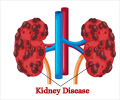Scientists have observed that patients suffering from metabolic syndrome tend to develop highly acidic urine, which increases the risk of developing kidney stones.
Scientists from UT Southwestern Medical Center have observed that patients suffering from the metabolic syndrome (a series of conditions that increases the risk for heart disease, stroke and diabetes ) tend to develop highly acidic urine, which increases the risk of developing kidney stones. The first study, to demonstrate this relationship independent of age and renal function, appears in the September issue of the Clinical Journal of the American Society of Nephrology.
The metabolic syndrome is characterized by a group of risk factors that include obesity, high blood pressure, diabetes and high cholesterol. The American Heart Association estimates that more than 50 million Americans suffer from the syndrome. “Our findings suggest that the presence of an increasing number of metabolic syndrome features augments the propensity for uric-acid stone formation,” said Dr. Naim Maalouf, assistant professor of internal medicine and the study’s lead author.In previous studies, UT Southwestern researchers have found that people who were overweight or suffered from diabetes had highly acidic urine, which often leads to the development of uric-acid kidney stones. The current findings indicate that people with the other components leading to the metabolic syndrome also have highly acidic urine.
“The association of highly acidic urine with elevated levels of systolic blood pressure, serum glucose, triglycerides and lower levels of high-density lipoprotein cholesterol — all features of the metabolic syndrome — has not been previously reported,” Dr. Maalouf said.
In the study, researchers recorded the height, weight and blood pressure of 148 participants who had never developed kidney stones. They also gathered blood and urine samples and tested the blood for features of the metabolic syndrome. They found that participants with the metabolic syndrome had highly acidic urine, compared to participants without the syndrome, and the correlation was independent of factors already known to influence urine acidity such as age, gender and body weight.
“This is the first time it has been shown that acidic urine, a major cause of uric-acid stone disease, is a part of the metabolic syndrome,” said Dr. Khashayar Sakhaee, chief of mineral metabolism at UT Southwestern and senior author of the study. “We also found that the relationship is not driven by body mass alone.” Uric-acid stones are more difficult to diagnose than other types of kidney stones because they don’t show up on regular abdominal X-rays, often delaying the diagnosis and leading to the continued growth of a stone.
Other UT Southwestern researchers contributing to the study were Dr. Orson Moe, director of the Charles and Jane Pak Center for Mineral Metabolism and Clinical Research, and Beverley Adams-Huet, assistant professor of clinical sciences. The research was supported by the National Institutes of Health and the National Kidney Foundation.
Source-Eurekalert
ANN /J











